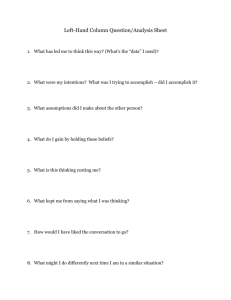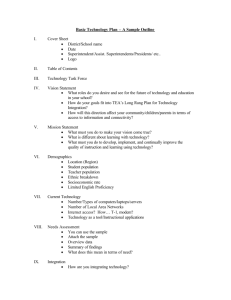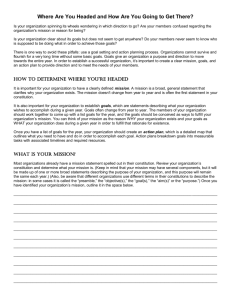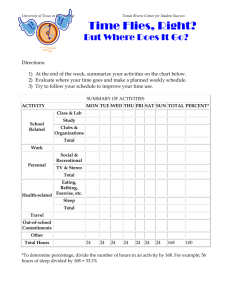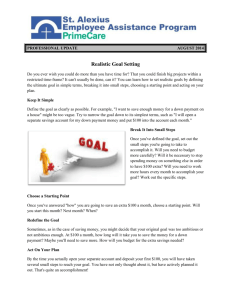Strengthening Our Use of Groups handout (doc)
advertisement
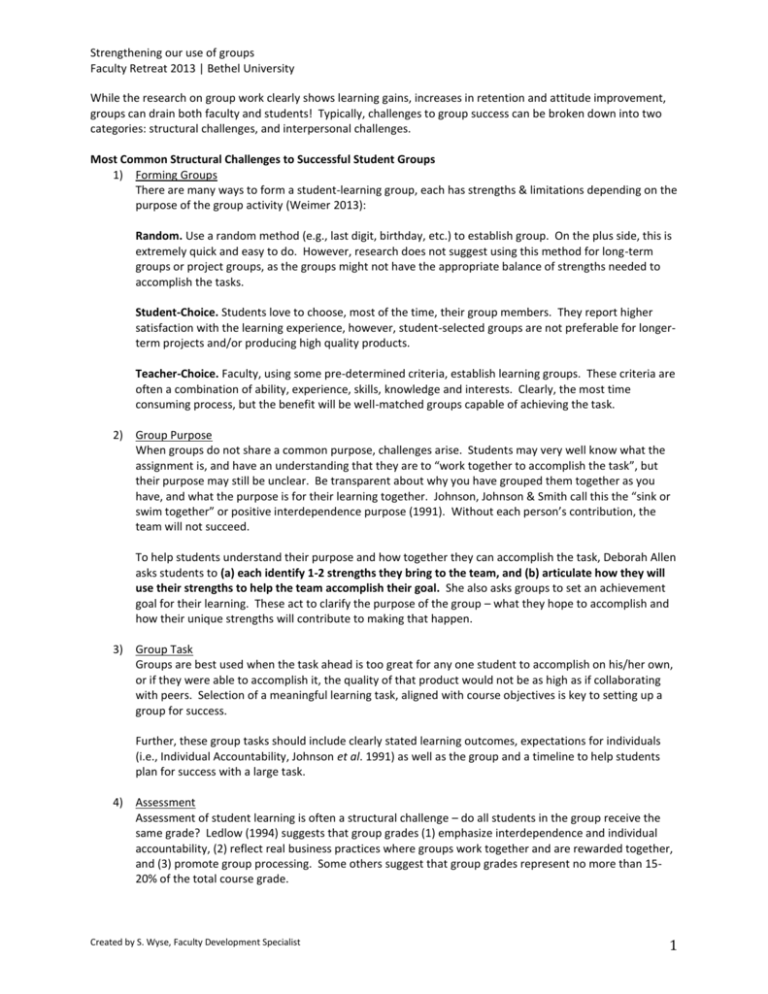
Strengthening our use of groups Faculty Retreat 2013 | Bethel University While the research on group work clearly shows learning gains, increases in retention and attitude improvement, groups can drain both faculty and students! Typically, challenges to group success can be broken down into two categories: structural challenges, and interpersonal challenges. Most Common Structural Challenges to Successful Student Groups 1) Forming Groups There are many ways to form a student-learning group, each has strengths & limitations depending on the purpose of the group activity (Weimer 2013): Random. Use a random method (e.g., last digit, birthday, etc.) to establish group. On the plus side, this is extremely quick and easy to do. However, research does not suggest using this method for long-term groups or project groups, as the groups might not have the appropriate balance of strengths needed to accomplish the tasks. Student-Choice. Students love to choose, most of the time, their group members. They report higher satisfaction with the learning experience, however, student-selected groups are not preferable for longerterm projects and/or producing high quality products. Teacher-Choice. Faculty, using some pre-determined criteria, establish learning groups. These criteria are often a combination of ability, experience, skills, knowledge and interests. Clearly, the most time consuming process, but the benefit will be well-matched groups capable of achieving the task. 2) Group Purpose When groups do not share a common purpose, challenges arise. Students may very well know what the assignment is, and have an understanding that they are to “work together to accomplish the task”, but their purpose may still be unclear. Be transparent about why you have grouped them together as you have, and what the purpose is for their learning together. Johnson, Johnson & Smith call this the “sink or swim together” or positive interdependence purpose (1991). Without each person’s contribution, the team will not succeed. To help students understand their purpose and how together they can accomplish the task, Deborah Allen asks students to (a) each identify 1-2 strengths they bring to the team, and (b) articulate how they will use their strengths to help the team accomplish their goal. She also asks groups to set an achievement goal for their learning. These act to clarify the purpose of the group – what they hope to accomplish and how their unique strengths will contribute to making that happen. 3) Group Task Groups are best used when the task ahead is too great for any one student to accomplish on his/her own, or if they were able to accomplish it, the quality of that product would not be as high as if collaborating with peers. Selection of a meaningful learning task, aligned with course objectives is key to setting up a group for success. Further, these group tasks should include clearly stated learning outcomes, expectations for individuals (i.e., Individual Accountability, Johnson et al. 1991) as well as the group and a timeline to help students plan for success with a large task. 4) Assessment Assessment of student learning is often a structural challenge – do all students in the group receive the same grade? Ledlow (1994) suggests that group grades (1) emphasize interdependence and individual accountability, (2) reflect real business practices where groups work together and are rewarded together, and (3) promote group processing. Some others suggest that group grades represent no more than 1520% of the total course grade. Created by S. Wyse, Faculty Development Specialist 1 Strengthening our use of groups Faculty Retreat 2013 | Bethel University If you decide on some form of group grades, here are some possible ways to consider assessing group learning (Johnson & Johnson 1999, Azwell 1995 and Furtwengler 1995): Average the scores of all members to create a group grade Total the scores of all members to create a group grade Find a group average and then add this average to each individual’s score Randomly grade one group member’s work as a group grade During class, randomly call on a group member to answer on behalf of the group Grade individually, but provide a group bonus if all group members score above a cut-off value Grade individually, but reward the group for learning gains over the course of the semester with a bonus “group score” Grade the group project collectively, but provide individual grades for the components leading up to the project Grade the group project, but provide individual non-academic grades for student peer evaluations, for example Assessment strategies may also look different in teams; consider using a pyramid exam structure to assess the impact of group learning vs. individual learning. In this model, students take the assessment first as an individual and then as a team. Or they take the assessment first as an individual, get together with their team to talk through the assessment, and return to take a second version of the assessment on their own. Most Common Interpersonal Challenges to Successful Student Groups 1) Communication Breakdown A communication breakdown, or a mismatch in communication expectations is the top reason for challenges to arise within groups. Taking preventative steps at the onset of group work can help prevent these communication breakdowns. This can be accomplished in a number of ways: a. Group Communication Contract Collectively, the group creates a contract to which each group member agrees to uphold for the duration of the project. The team answers two fundamental questions (adapted from D. Allen): (1) How will we communicate (e.g., text, FB, email)? Student take time in class to exchange contact information. (2) What are our expectations for communication (e.g., response time, when is it OK to re-contact? Is it ever OK to come to your dorm, etc)? Students discuss and record the answers to these questions. Prompt students with hypothetical situations, “what if you sent an email about a group meeting…” as they discuss. b. Group Communication Skills Building Often, our learning outcomes for group work relate to students building communication and interpersonal skills, yet we often are not explicit in helping them develop these skills. Rather, they happen as a result of trial and error. Karl Smith suggests that being intentional about teaching group communication skills, such as active listening, can help prevent communication breakdowns. Karl has some great listening activities, such as the Plus/Delta Form which teams fill out after a short learning task has occurred. Teams reflect on what they did well vs. what they would like to change in the future. Karl’s 2004 book has a great list on pgs. 39-40 of skills students can build in the context of groups. Even providing students with such a list can help! c. GEAs (Group Effort Analysis) Giving students a chance to reflect on and share how things are going in their team is key to group success. These GEAs should be conducted at a regular interval, beginning as early as 1 week after group formation. These can be done in writing through a 1-minute paper (e.g., explain a successful group interaction from the week, or what was an area of conflict in your group this week and how did you resolve it?), through a prompted individual “evaluation” of each group member’s contributions, through a reflection revisiting one’s own behavior relative Created by S. Wyse, Faculty Development Specialist 2 Strengthening our use of groups Faculty Retreat 2013 | Bethel University to the group contract, or through a discussion within the context of the team, guided or unguided by you as a faculty member. 2) Dominating Student and/or Freeloading Student a. Individual accountability Structuring group tasks such that each student is required to be individually accountable for their learning is a successful way to draw in the student who might be tempted to freeload. Simultaneously, it requires the dominating student to give up the ability to control each group member. b. GEAs (Group Effort Analyses) Providing students with opportunities to first personally reflect on how they are contributing to the team, how they are encouraging others, and what things are going well/not well, is extremely valuable. Often, both freeloaders and dominating students will recognize their need to “contribute more” or “back off” and providing suggestions to both for how to do this can be very helpful. Students might see what they should do, but don’t know how to make it happen. Your mentorship here either collectively to the class (e.g., “if you feel like you need to contribute more, here are three steps you can take with your team…. ), or on an individual basis. Concluding these with an action plan or action steps makes them most useful. 3) Lack of Community Sometimes, teams struggle. They may not connect well with one another in class or outside of class. This may be because the teams don’t really know one another. To help, consider intentionally building community. Help students learn how to meet people – what kinds of questions to ask, how to find things they have in common, how to listen well and learn about one another. Students often have some of these skills, and they are being developed in the dorms and through Student Life on campus daily, yet student struggle to transfer these skills into the classroom. You will need to provide class time for this to occur, but the payoff in a few weeks will be great. Created by S. Wyse, Faculty Development Specialist 3
